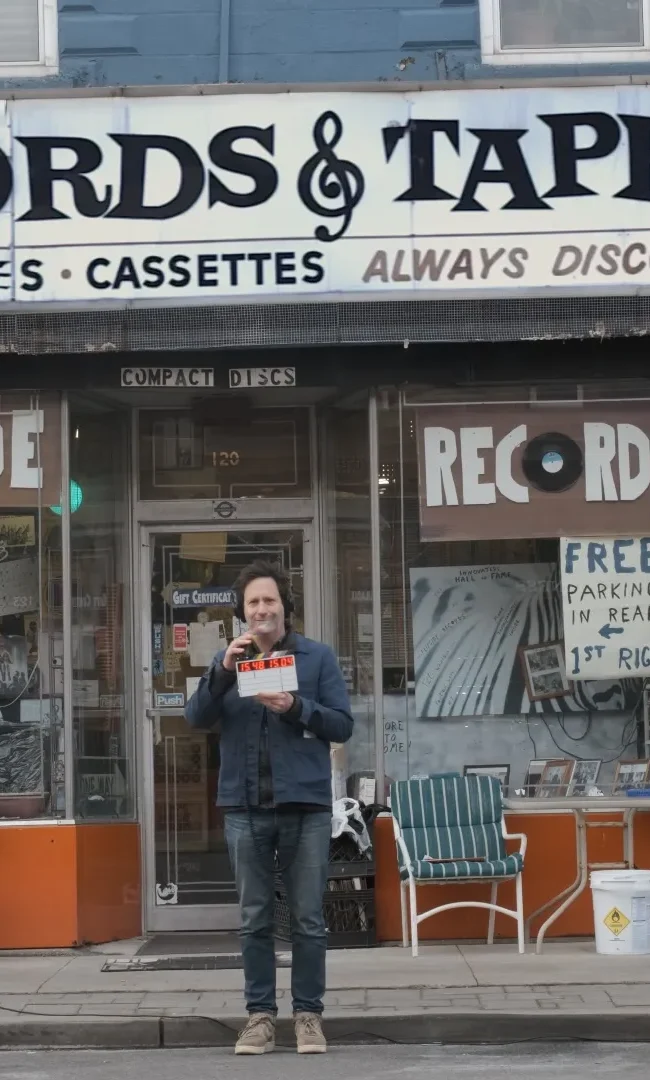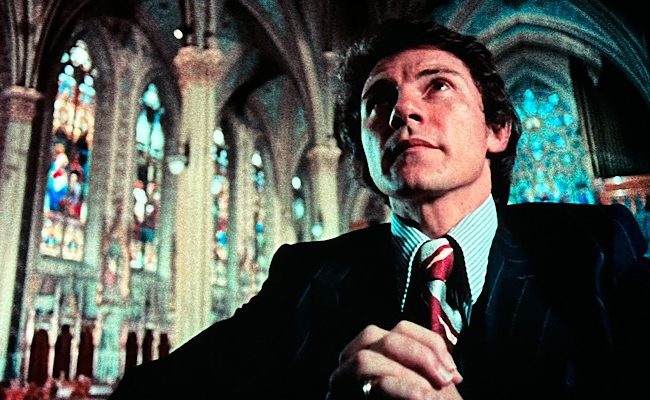A Conversation with Tommy Pallotta and Femke Wolting (MORE HUMAN THAN HUMAN)
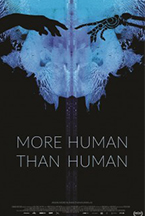 I met with directors and real-life partners Tommy Pallotta and Femke Wolting, of the new documentary feature More Human Than Human (which I also reviewed), on Sunday, March 11, at the 2018 SXSW Film Festival, with my Fog of Truth podcast colleague Bart Weiss (of Dallas VideoFest) – who knows Tommy – joining me for the conversation. The film discusses the many different forms of Artificial Intelligence (AI) today, with interviews from a wide range of talking-head experts, filled with predictions both dire (we are doomed!), optimistic (AI is wonderful!) and somewhere in between. Curious about 21st-century robotics? Then this is the movie for you. Here is a condensed digest of our conversation, edited for clarity.
I met with directors and real-life partners Tommy Pallotta and Femke Wolting, of the new documentary feature More Human Than Human (which I also reviewed), on Sunday, March 11, at the 2018 SXSW Film Festival, with my Fog of Truth podcast colleague Bart Weiss (of Dallas VideoFest) – who knows Tommy – joining me for the conversation. The film discusses the many different forms of Artificial Intelligence (AI) today, with interviews from a wide range of talking-head experts, filled with predictions both dire (we are doomed!), optimistic (AI is wonderful!) and somewhere in between. Curious about 21st-century robotics? Then this is the movie for you. Here is a condensed digest of our conversation, edited for clarity.
Hammer to Nail: So, in 2014, which was my first time at SXSW, I saw your movie The Last Hijack, which is about Somali pirates and is a wonderful mix of hybrid techniques, with animation, re-enactments, and then traditional documentary elements, as well. I enjoyed it, but it’s miles away from this particular subject. So I have a two-part question: 1) How did you get from there to here?, and 2) How long have you two worked together?
Bart Weiss: And if you could add to that: how did you actually collaborate on this film? Because Tommy is in it. How did that all work?
Femke Wolting: We’ve known each for a long time. We don’t remember the first time we met each other, but I worked at the Rotterdam Film Festival, as a curator, in the ’90s. Tommy was making films and he would show them at the festival, so we became friends, at that time. And then we became a couple maybe a decade later, around 2008. Tommy moved to Amsterdam, we started collaborating then on a number of different projects. We did a 3D film in Abu Dhabi. We started working on The Last Hijack. Tommy directed a kind of interactive film-game called Collapsus, that I produced. We don’t work together all the time; we also do a lot of stuff without each other, but sometimes it’s nice to find each other in a project and collaborate.
Tommy Pallotta: Yeah. I mean, we’ve been doing this for over two decades. In that original era – and Bart was part of this, too – when people were looking at technology in storytelling, it was a very small group of people, and we all tended to know each other. We’ve all sort of grown as it’s become more mainstream, and almost a non-issue, in terms of the technology, but to have that sort of kinship with people who were there at the beginning, is an important bond for all of us.
BW: So, how did this project evolve? I know the intersection, you said, of storytelling, art and technology has been a core of all of your work…
[Bart’s iPhone speaks up, Siri having misheard a launch command]
BW:…there you go, there’s AI working with us, at this very moment. (laughs) So, how did you decide to make this into a film?
TP: Well, we have another project, which is our daughter, who is 8 right now, and I think that we were such huge believers in technology, and really embracing that, but then when you have a child, I think that we started to look at technology differently. I remember the first time our daughter went to a TV and she tried to touch it and swipe it, and then when it didn’t do anything, she was just sort of like, “It’s dead to me.” And then we started having arguments about the iPad, which she was required to have in kindergarten, as an educational tool, and that sort of shocked me. I thought, “They have to have an iPad, in kindergarten?”
And then there were the inevitable arguments about the iPad in the house. I got really frustrated, and I threw it in the trash one day, and everybody freaked out, and I was like: “Look, this is a piece of plastic. It’s a tool. It’s not a fetish, it’s not something that is desirable or better than anything else. It’s just a tool that you can use.” And I think at that point, I started really thinking about how I grew up in a world that was analog and watched it transform into digital. What’s it going to be like for these people – my daughter – who have never known the analog beginnings and genesis of all this? And so we started wondering how it was affecting everyone’s relationship. What kind of world is she going to grow up in?
FW: And because we have always worked so much with technology and film, and always were very excited about all the new possibilities it offered to storytelling and to art and to us, as filmmakers, we felt that it was important to look at AI with a very open mind, but to also be critical about it. I had done this film in the late ’90s called It’s the End of TV As We Know It, which was all about the rise of the internet, and it was really this exciting time of how the internet was going to be this medium where you could publish and distribute … and now, almost 20 years later, you see how big corporations have come in, and the influence of AI, so we felt it was an important moment to tell our biggest story about AI and to really make people aware that this is the moment where it’s being designed, for decades to come. It’s important to be aware of it and be a part of the conversation.
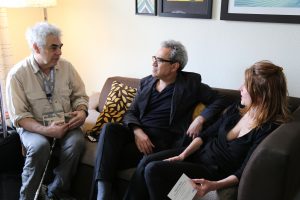
Bart Weiss, Tommy Pallotta and Femke Wolting
BW: To me, the most interesting part of the film, although all the interviews and all the characters are really good, is the idea of trying to program a camera to shoot the interview with you, Tommy, and to ask the questions of you. This is taking the core elements of story and attaching them to the process, in a very self-reflexive way. Being that that’s a very risky thing, what were the discussions about it? “Should we do it, should we not do it?” And how do you feel about how it works in the film.
FW: We talked about it a lot. On the one hand, we thought it was a great way to tell the story from a more personal angle, because it’s such a big subject, going from health care to the economy to social media to … everything … and to go through this vast world of AI and not be completely lost in it, it’s nice to hold onto somebody’s personal perspective, to make it more human, otherwise it would be too abstract.
And then, of course, there was a lot of discussion about “Can we do it? How do we do it? With whom are we going to make it?” Because we had never built a robot before, so we had to find the best programmers to do this with, to find people who were willing to help finance this and help design it. In the end, Carnegie Mellon offered us a lab to work in, and Tommy found a number of great programmers to work with, and then, I think, we were kind of astonished at how much we got done in a reasonably short amount of time.
TP: Yeah, I felt that it was really important, because it’s such an abstract concept. I’m not a programmer, and I wanted to get my hands dirty and really understand what AI is. It’s not like a magic thing where you just press a button and it knows what to do. We haven’t reached singularity, yet. So, I think it was really about showing myself and the audience what it takes to make AI, which is a lot of human programming. You have to teach it everything. And I think that really comes back to the theme of the movie, which is that we have a sense of responsibility … we should have a sense of responsibility for the technology that we’re creating, because ultimately, it’s a reflection of who we are.
And so, if we’re creating AI, and it’s funded by the military, and its objective is to kill people, then we’re going to get AI that really knows how to kill people. If it’s a hyper-capitalistic AI algorithm to manipulate people to buy things that they don’t need, then that’s what’s going to be running our world. So, the analogy is that it’s like a parent to a child, that we should have a sense of obligation and duty to imbue our creations with the best that we have to offer, and we need to be aware if we’re imbuing them with ideas and ethics that aren’t going to benefit us in the long term.
HtN: Sure. And you have a good range of AI in the film, from things that are potentially scary to a singing robot. In fact, you end the film with the singing robot, so it’s kind of hopeful, in that sense. So, I have a question about that robot camera. Part of the interesting trajectory of that whole experience in the movie is that at the end of the film it performs in a certain way, and I’m just curious if that is an ongoing process. Are they going to keep on working with the robot? What’s the future of this AI camera?
TP: Well, when we started to develop this project, the one thing that I wanted to make sure would happen was that it would be open-source. So, we’re going to be releasing all the code, and we’re also going to continue to develop it on our own and hope that the community at large will also help contribute to it and continue to develop it.
BW: What’s interesting about that is that you’re essentially putting us all out of business.
HtN: Without giving away any plot spoilers, I think that there’s a long way to go before you’re putting us out of business with that robot camera.
FW: I think, at the same time, that there are a lot of elements in filmmaking that are impacted by AI, from editing systems, visual effects, even translation programs that now translate better than human translators, in certain languages. There are all these little steps, already, where AI is already impacting film jobs. And maybe it’s still far away where AI will direct the whole film, but at the same time, it’s something that young people today…they will interact with AI when making films. I’m sure about that.
HtN: One of the ways, however, in which your humanity has an impact on this film, in a way that, at least for now, no AI could, is in your choice of how to compose your interviews. Traditionally, interview subjects will be on the right or the left of the frame, and look across the frame. But in almost every single talking-head interview that you have, they’re on one side of the frame and looking off in that same direction, rather than cross-frame. Could you talk about your decision to frame the interviews in that way?
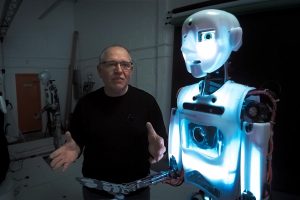
TP: Yeah, yeah. That’s a good observation. When we started this project, I was interested in throwing away the idea of a talking-head documentary. And we shot the entire film on a GoPro.
HtN: Even the talking heads?
BW: Yes. They’re all wide.
HtN: Yeah, but wide is one thing, GoPro is another. Wow! That’s interesting!
BW: I sort of got that halfway. In particular, there is that one interview where the camera is pretty aggressively moving, which is so different than all the other ones. What was going on that day?
TP: Well, we knew that we were going to be building the camera-bot, and some of the interviews, we did in the studio. At one point, we thought we would take the camera-bot with us, to conduct the interviews, as well. And what I wanted to do was sort of blur the line between if a human was filming it or the camera-bot was filming it. And I was also playing with perspective: is this the human perspective or the camera-bot’s perspective? It kind of shows humans, on a compositional level, as not the center of the frame, or the focus. You know, sort of like when the computer sees us, with the human almost out of frame, and a little bit skewed.
So, it takes you a little bit off, and away from the human side, to play with that notion of perspective: the machine perspective or the human perspective. And in some scenes, we’re switching between both. And so it was really about creating that continuity and almost blurring that line, because I think that’s the point where we’re at, right now. We’re at that point where human and machine are actually cohabiting and are hybrid, and that line is blurred, presently, today, in our society. So, it was a way to use that composition to drive that idea home.
HtN: Interesting. So, I have one more question. At one point, certain people show up in the frame at Carnegie Mellon: the actor Billy Crudup and the director Richard Linklater. Were you working with them at that time, on something else?
TP: Total accident. Totally random accident. Rick and Billy were in Pittsburgh, shooting a film, and Billy Crudup plays a technology guru, and Rick and I were talking, and I said, “Just come on down and check it out. We’re building robots.” So, they came down to say hi and support us, but also as research.
HtN: That’s interesting. Well, thank you both very much. This was a very interesting film.
– Christopher Llewellyn Reed (@ChrisReedFilm)








